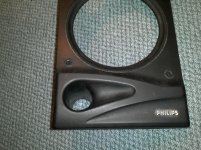I am building a new enclosure for some cheap Philips speakers (into a single unit boom box). I cant find specs for any of the drivers, so I am just going to build them the same size as the originals.
The enclosure volume is easy to duplicate, but how do I measure / duplicate the ports? They are flared on the front.
The enclosure volume is easy to duplicate, but how do I measure / duplicate the ports? They are flared on the front.
Attachments
Do you have any measuring/test equipment at all ?
A WT3 , or a signal generator, or even a CD with test tones of various low frequencies ?
If you have any of those, you can re-mount the woofers in their original cabinets and test them.
With the WT3 , just run a sweep , the low point in the woofers resonant peak is the frequency of the port tuning.
If you have a signal generator or test tones, adjust the frequency , going from low frequencies and gradually increasing until the woofer barely moves, then continue past until the woofer starts to move again. The point where the woofer is barely moving is the port tuning frequency.
If ball park is all you are looking for, measure the inside diameter of the tube , and the length from the inside edge to the outside edge. I would measure to the non-flared (longer length) edge. The flare on that setup is mostly cosmetic, although it will have some effect.
.......................Blake
A WT3 , or a signal generator, or even a CD with test tones of various low frequencies ?
If you have any of those, you can re-mount the woofers in their original cabinets and test them.
With the WT3 , just run a sweep , the low point in the woofers resonant peak is the frequency of the port tuning.
If you have a signal generator or test tones, adjust the frequency , going from low frequencies and gradually increasing until the woofer barely moves, then continue past until the woofer starts to move again. The point where the woofer is barely moving is the port tuning frequency.
If ball park is all you are looking for, measure the inside diameter of the tube , and the length from the inside edge to the outside edge. I would measure to the non-flared (longer length) edge. The flare on that setup is mostly cosmetic, although it will have some effect.
.......................Blake
Only test equipment I have would be a pc and a multimeter. So a woofers resonant frequency in a cabinet = the port tuning frequency? Think that's all I needed to know! I'm sure I can measure that close enough.
If my measurements are off a bit, how much would this likely affect the sound? These weren't high end speakers to begin with, and the boombox will be used mostly outdoors to play to (likely drinking) non audiophiles 🙂
If my measurements are off a bit, how much would this likely affect the sound? These weren't high end speakers to begin with, and the boombox will be used mostly outdoors to play to (likely drinking) non audiophiles 🙂
If you round over a regular duct of the same diameter the tuning will be within a few Hz either way.Only test equipment I have would be a pc and a multimeter. So a woofers resonant frequency in a cabinet = the port tuning frequency? Think that's all I needed to know! I'm sure I can measure that close enough.
If my measurements are off a bit, how much would this likely affect the sound? These weren't high end speakers to begin with, and the boombox will be used mostly outdoors to play to (likely drinking) non audiophiles 🙂
90% would notice no difference, 2.5% would like a lower tuning better, 2.5% would like the cabinet tuned higher, 5% would be asking for another beer in answer to which Fb was better.
re:"5% would be asking for another beer" - that's me...
I agree, just use the dia & length, the flare won't make much difference.
If want a more punchy sound (at the expense of low bass), make the pipe shorter, if you want more low bass (at the expense of level) make the pipe longer.
Bear in mind it's easier to make a pipe shorter than longer if you change your mind...
I agree, just use the dia & length, the flare won't make much difference.
If want a more punchy sound (at the expense of low bass), make the pipe shorter, if you want more low bass (at the expense of level) make the pipe longer.
Bear in mind it's easier to make a pipe shorter than longer if you change your mind...
OK, all sounds good, a few Hz will not be noticed I'm sure! Although your estimation of the percent asking for another beer would be on the low side for my friends! 🙂 I'll try and measure the resonant frequency in the old enclosure for fun / learning, but I'll probably just put in a pipe same dia and a little bit longer, like you say, cutting it shorter is easy (cutting it longer not so much!)
- Status
- Not open for further replies.

